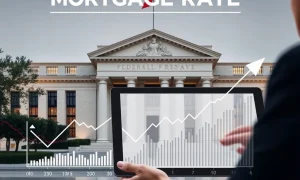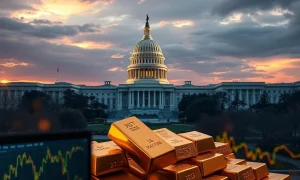Recent economic data revealed a notable uptick in the inflation rate, sparking fresh discussions among investors and policymakers. The Consumer Price Index (CPI) report, a key measure of the inflation rate, showed its largest monthly increase in six months. This development has naturally raised questions. Despite this rise, many analysts still believe a Federal Reserve interest rate cut remains a distinct possibility this year. Understanding this complex economic landscape requires a closer look. Business leaders and entrepreneurs especially monitor these trends closely. They impact everything from supply chain costs to consumer spending power.
Understanding the Latest Inflation Rate Data
The recent CPI report indicated a significant acceleration in the overall inflation rate. This increase was primarily driven by specific sectors. For instance, energy prices saw a notable rebound. Housing costs, including rent and owners’ equivalent rent, also continued their upward trajectory. These components heavily influence the headline inflation rate. Food prices, however, showed more moderate increases. Core CPI, which excludes volatile food and energy components, also registered a rise. This suggests broader price pressures within the economy. Policymakers closely examine both headline and core inflation rate figures. They seek to identify underlying trends versus temporary fluctuations.
Key takeaways from the recent CPI report:
- Headline CPI: Showed the largest monthly increase in six months.
- Energy Prices: Contributed significantly to the rise.
- Housing Costs: Continued their steady ascent.
- Core CPI: Also increased, indicating broad-based pressures.
Implications for Federal Reserve Policy and the Inflation Rate
The Federal Reserve operates under a dual mandate. It aims to achieve maximum employment and price stability. A rising inflation rate complicates the second goal. Fed officials prefer to see the inflation rate moving sustainably towards their 2% target. The recent CPI data presents a challenge to this objective. It indicates that the path to a lower inflation rate might be bumpy. Consequently, the Fed faces a delicate balancing act. They must weigh the risks of persistent price pressures against potential economic slowdowns. Fed Chair Jerome Powell has consistently emphasized patience. He stresses the need for more evidence of a declining inflation rate before considering rate cuts. This latest report underscores that cautious approach.
Why a Fed Rate Cut Remains Possible Despite the Rising Inflation Rate
Despite the headline increase in the inflation rate, several factors keep a rate cut in play. First, some economists view the recent rise as potentially temporary. Seasonal factors or one-off price adjustments can influence monthly data. Second, the broader disinflationary trend over the past year remains intact. The inflation rate has significantly cooled from its peak levels. Third, the labor market shows signs of cooling, albeit gradually. This easing can reduce wage pressures over time. Finally, the Fed’s forward guidance often considers future economic projections. They do not solely react to single data points. Therefore, a comprehensive view of economic health still suggests room for policy easing. This outlook provides some optimism for market participants.
Market Reactions and Investor Outlook Amidst the Shifting Inflation Rate
Financial markets reacted with a mix of caution and resilience. Initial investor sentiment often turns bearish on higher inflation rate reports. This can signal delayed rate cuts. However, the underlying belief in a future Fed pivot persists. Equity markets saw some volatility but largely held their ground. Bond yields experienced upward pressure, reflecting expectations of higher-for-longer rates. Yet, the overall narrative suggests that a mild rise in the inflation rate might not derail the entire easing cycle. Investors are closely monitoring upcoming economic releases. They look for further clues on the Fed’s next move. Certain sectors are more sensitive to the inflation rate. Consumer staples might feel pressure from higher input costs. Technology stocks, conversely, often benefit from lower interest rates.
Historical Context of Inflation Rates and Policy Responses
Understanding current trends benefits from historical perspective. The current inflation rate environment differs significantly from past decades. For instance, the 1970s saw persistent, high inflation rates. This led to aggressive rate hikes by the Fed. More recently, post-2008, the Fed struggled to achieve its 2% inflation rate target. The pandemic era introduced unique supply-side shocks. These factors contributed to the recent surge in the inflation rate. Comparing these periods helps contextualize the Fed’s current dilemma. Today’s challenges are unique, demanding flexible policy responses. The Fed aims to avoid past mistakes.
Looking Ahead: Key Economic Indicators and the Future Inflation Rate
Investors and analysts are now keenly focused on several upcoming economic indicators. These will further shape expectations for the inflation rate and Fed policy. Key reports include:
- Producer Price Index (PPI): This measures wholesale inflation rate. It often signals future consumer price movements.
- Employment Situation Report: Wage growth and labor force participation influence the inflation rate.
- Personal Consumption Expenditures (PCE) Price Index: This is the Fed’s preferred measure of the inflation rate.
- Retail Sales Data: Consumer spending patterns directly impact demand-driven inflation rate.
Statements from Federal Reserve officials also carry significant weight. Their public remarks often provide insights into the Fed’s evolving views on the inflation rate and economic outlook.
The recent uptick in the inflation rate, as shown by the CPI report, marks a significant development. It highlights the ongoing complexities in the economic recovery. While this rise introduces some uncertainty, the possibility of a Federal Reserve rate cut remains on the table. This outcome hinges on future data. The Fed’s commitment to both price stability and maximum employment guides its decisions. Therefore, market participants must remain vigilant. They should closely monitor all incoming economic data. The delicate balance between managing the inflation rate and supporting economic growth continues to define the current monetary policy landscape.
Frequently Asked Questions (FAQs)
Q1: What is the Consumer Price Index (CPI)?
A1: The CPI measures the average change over time in the prices paid by urban consumers for a market basket of consumer goods and services. It is a key indicator of the inflation rate.
Q2: How does a rising inflation rate affect consumers?
A2: A rising inflation rate reduces purchasing power. This means your money buys less over time. It can also increase the cost of living and borrowing.
Q3: Why might the Fed still cut rates despite higher inflation rate?
A3: The Fed considers multiple factors, not just one month’s data. They look at overall disinflationary trends, labor market conditions, and future economic projections. They might view a single month’s rise as temporary.
Q4: What is the Fed’s target inflation rate?
A4: The Federal Reserve aims for a long-run inflation rate of 2%, as measured by the Personal Consumption Expenditures (PCE) price index.
Q5: How do interest rate cuts impact the stock market?
A5: Generally, interest rate cuts make borrowing cheaper. This can stimulate economic growth and boost corporate profits. Consequently, it often leads to higher stock prices, especially for growth-oriented companies.








